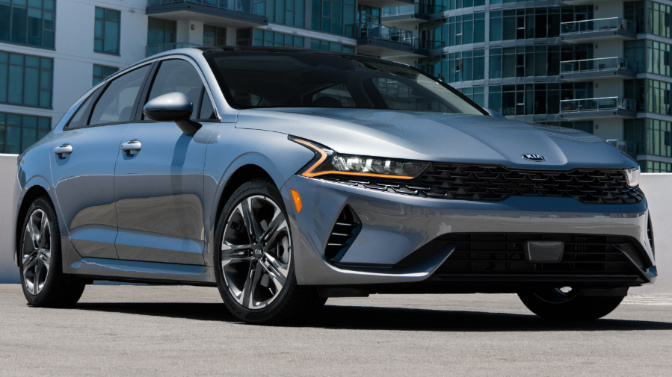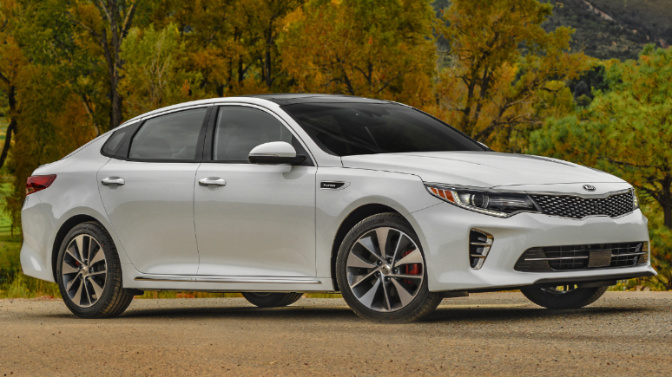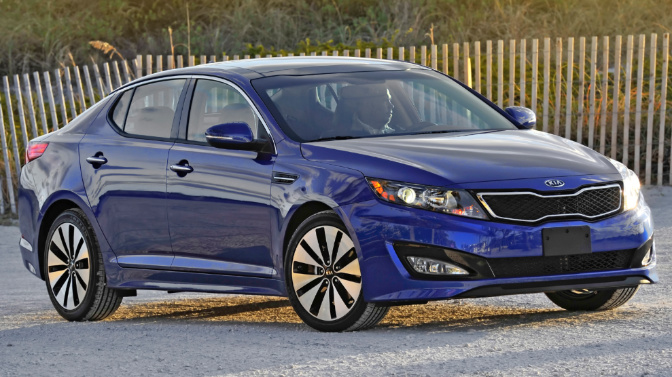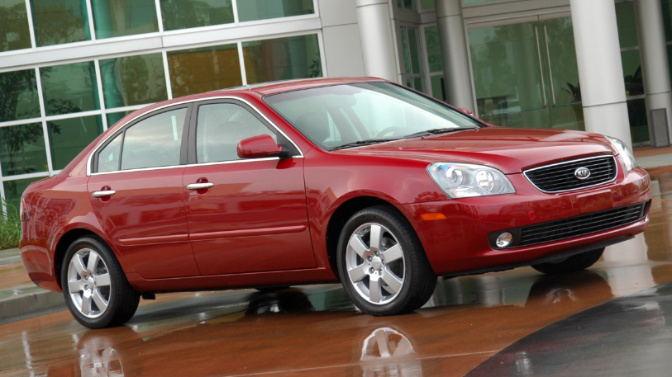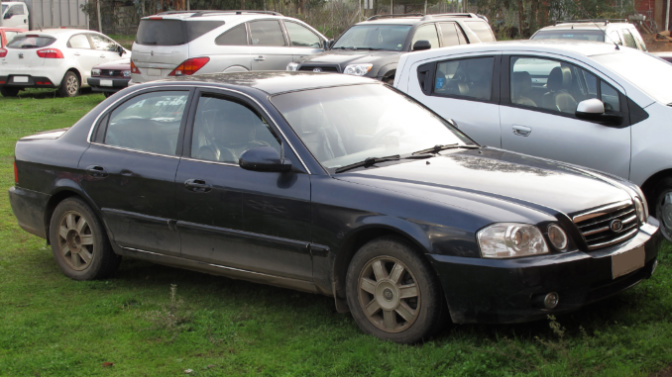Kia Optima & K5 Generations
The Kia Optima started as a quick attempt to give the fledgling brand from South Korea a broader lineup in the US. Before the Optima, Kia’s line consisted of small sedans and hatchbacks and a small SUV. By quickly introducing a midsize sedan, then the largest market segment, Kia had a better shot at grabbing more market share in the most significant new car market.
The Kia Optima, released in 2001, started as a thinly disguised Hyundai Sonata, following Kia’s sale to the fellow carmaker from South Korea a few years earlier. It gave Kia a model it never had before and expanded the brand into the competitive midsize sedan segment in the US, dominated by the Honda Accord and Toyota Camry and the Chevrolet Malibu and Ford Taurus.
While the Optima and Sonata have always shared components, Kia has increasingly exercised more freedom to give its sedan a style and personality of its own. As a result, it has made Optima a highly competitive vehicle as some other companies have given up on the segment altogether.
Even though the K5 name has replaced the Optima label worldwide, Kia’s midsize sedan continues to stake out its space as a value-focused vehicle that stands out a little from the competition.
2021 – Present Kia K5 (5th Generation)
Kia gave Optima another radical redesign for 2021 to stand out in a shrinking mainstream sedan market. But the most noticeable change was to the name. The Optima name was replaced by K5, which the car was always called in South Korea, as Kia standardized its nameplates.
Introduced for 2021, the new K5 upped the edge on the exterior design compared to the toned-down outgoing Optima. The shape took inspiration from the rear-wheel-drive Kia Stinger hatchback, while new lights were more reminiscent of premium cars. However, all K5s were four-door sedans. Certain models also received larger wheels and sportier details, inspired by the Stinger.
Inside, the K5 was completely made over and used larger screens, such as an available 12.3-inch TFT screen that replaced physical instrument panel gauges on some models. In addition, a 10.25-inch touchscreen for the infotainment system was also available on certain trim levels. The line consisted of the LX, LXS, GT-Line, EX, and GT.
Unlike other years, the engine lineup borrowed more liberally from the Sonata. Most models were equipped with a 180-horsepower, 1.6-liter turbocharged four-cylinder engine, and eight-speed automatic transmission. The K5 GT was bestowed a 290-horsepower, 2.5-liter turbo-four, and an eight-speed dual-clutch automated transmission. Breaking with tradition from the Optima, the K5 was not offered as a hybrid or plug-in hybrid (PHEV); the Sonata, which was still offered as a hybrid. However, the Kia was now offered with all-wheel-drive (AWD) on LXS and GT-Line models, something no Sonata offered. It also allowed the K5 to compete with rivals Nissan Altima and Toyota Camry that offered AWD with their base engines. The Subaru Legacy made it standard on every model. But the top GT model was limited to front-wheel-drive only.
For 2022, more K5 models received additional standard equipment on certain trim levels and the new Kia logo. In addition, EX and GT models got a surround-view camera, and more models added the 10.25-inch touchscreen upgrade as standard.
2016 – 2020 Kia Optima (4th Generation)
The fourth-generation Optima hit the US market in 2016. Kia refined the styling, mechanicals, and technology over the radical previous model.
The new Optima was offered in LX, EX, SX, and SXL trim levels. LX and EX models offered two powertrains: a 185-horsepower, 2.4-liter four-cylinder engine mated to a six-speed automatic transmission or a 178-horsepower, turbocharged 1.6-liter four-cylinder engine mated to a seven-speed dual-clutch automated transmission. The SX and SXL models used a 245-horsepower, turbocharged 2.0-liter four-cylinder engine coupled with a six-speed automatic transmission.
While the Optima Hybrid returned mostly unchanged, a plug-in hybrid version was newly available during 2016. The Optima PHEV used a 2.0-liter four-cylinder engine and an electric motor, along with a 9.8-kWh battery pack to deliver about 27 miles of electric-only range.
Other new features on the 2016 Optima were Apple CarPlay and Android Auto connectivity, blind-spot monitoring, a driver attention monitoring system, and other driver assistance technology. The passenger space inside was also slightly increased.
While there was a modest exterior revision for 2019, the fourth-generation Optima mainly went unchanged throughout its five-year life, save for the addition of more standard equipment on all trim levels.
2011 – 2015 Kia Optima (3rd Generation)
For 2011, Kia introduced the third-generation Optima, a sharp departure for the brand and the segment. With a new elegant exterior, classy interior, new engines, and a hybrid option, Kia set the Optima apart from mainstream competitors in a bid to its midsize sedan. The styling was far more aggressive than before as it ushered in new design cues for Kia, with hints of European designs added by the company’s designer lured away from Audi.
The carryover mainstream LX and EX trims used a new 200-horsepower, 2.4-liter four-cylinder engine, with a six-speed manual transmission standard on the LX and a six-speed automatic standard on the EX and available on the base model.
The new EX Turbo and SX replaced the formerly optional V6 with a new 274-horsepower, 2.0-liter turbo four-cylinder. And during 2011, the first Optima Hybrid was released. The standalone gas-electric hybrid trim level received a 2.4-liter four-cylinder engine with an electric motor for 206 total system output. The fuel economy was rated as high as 38 mpg. Both of these powertrains were mated exclusively to the six-speed automatic transmission.
The interior was more driver-focused than before, again mimicking premium European cars. Significant new standard and available features included USB connectivity for mobile devices, keyless entry with push-button start, a panoramic moonroof, heated rear seats, cooled front seats, and a backup camera. Kia’s UVO infotainment system with hands-free phone and multimedia connectivity was offered on most Optimas.
For 2013 Kia modified the Optima’s trim lineup, discontinuing the EX Turbo and splitting the hybrid into LX and EX trims. Both hybrid models carry the same powertrain but offer different feature packages. The manual transmission option for the base LX model was also eliminated.
There were modest styling updates for 2014 and the addition of a highly-equipped SXL model using the turbo engine and just about every available option. But the third-generation Optima was such a success that Kia didn’t change much until a redesigned model arrived for 2016.
2007 – 2010 Kia Optima (2nd Generation)
Entirely new from the ground up, the second-generation Optima was released for 2007. While it still shared many pieces with the redesigned 2006 Sonata, Kia differentiated Optima’s styling more than before.
The Optima was still available in LX and EX models and two powertrain options. A new 161-horsepower, 2.4-liter four-cylinder engine was standard. The LX trim was mated to a standard five-speed manual transmission or optional five-speed automatic transmission, while the EX came only with the automatic. A 185-horsepower, 2.7-liter V6 was available and only with the automatic.
Not only was the new Optima larger in most dimensions, but it was also significantly more refined, with a more contemporary design and options like a built-in navigation system. A more robust structure and standard safety features like electronic stability control and side curtain airbags boosted its crash test scores, too.
For 2009, Kia gave the Optima lineup a facelift with minor styling tweaks and a sport-oriented SX model. Standard features on all models include 16-inch steel wheels, power amenities, and a six-speaker sound system with a CD player, satellite radio, and auxiliary and USB audio jacks. At the same time, keyless entry and push-button start were newly available. Power specs were boosted, too, with the four-cylinder now making 176 horsepower and the V6 with 195.
The second Optima iteration did well for Kia, but the company was about to make an even more serious attempt at cornering the midsize sedan market.
2001 – 2006 Kia Optima (1st Generation)
The first-generation Kia Optima was heavily based on the Hyundai Sonata, following the merger of the two South Korean automakers. It was also Kia’s largest and most expensive model at its release for 2001 before the Sedona minivan arrived the following year. However, while the exterior styling was modestly altered from the Sonata, the interior and mechanicals were nearly identical.
LX and better-equipped EX models were offered. Both came with a 149-horsepower, 2.4-liter four-cylinder engine as standard equipment, which was mated to either a five-speed manual transmission or an optional four-speed automatic. A more powerful 170-horsepower, 2.5-liter V6, and a four-speed automatic transmission were available. All Optimas were well-equipped with air conditioning, power amenities, and even side impact airbags, while EX models could be optioned with alloy wheels, leather upholstery and a sunroof.
For 2002, the V6 engine got a power bump to 176 horsepower, and LX models got larger 15-inch wheels. Kia restyled the Optima the following year with a new grille and headlamps. Inside, the Optima received a new dashboard design and seat material while adding cruise control and a CD player as standard equipment, and for 2004, Kia changed the grille again.
Despite minimal attention over its life, the Optima was a modest success for Kia. And it would take a more significant step towards being a contender for 2007.
